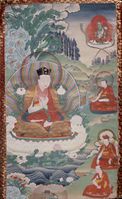Third Karmapa Rangjung Dorje
Karmapa, 3rd
| PersonType | Category:Classical Tibetan Authors |
|---|---|
| MainNamePhon | Third Karmapa Rangjung Dorje |
| MainNameTib | རང་བྱུང་རྡོ་རྗེ་ |
| MainNameWylie | rang byung rdo rje |
| AltNamesTib | ཀརྨ་པ་གསུམ་པ་ |
| AltNamesWylie | karma pa gsum pa |
| AltNamesOther | Karmapa, 3rd |
| BiographicalInfo | Important master of the karma kaM tshang tradition; he is regarded as the first of the incarnation lamas in tibet, since he became widely recognized as the embodiment of karma pak+Si.
He was installed first at karma dgon and then established at kam po gnas nang.
He is famed for the building of the iron bridge over the sog chu.
In 1331 he was invited to court by the yuan emperor and received by prince rat+na shrI.
After the prince's demise, his elder brother brought him to sman rtse.
According to the bod kyi gal che'i lo rgyus he died at 56. |
| YearBirth | 1284 |
| YearDeath | 1339 |
| BornIn | tsa phu gangs zhur mo |
| TibDateGender | Male |
| TibDateElement | Wood |
| TibDateAnimal | Monkey |
| TibDateRabjung | 5 |
| ReligiousAffiliation | Karma Kagyu |
| EmanationOf | Second Karmapa Karma Pakshi |
| StudentOf | o rgyan pa rin chen dpal · rig 'dzin ku mA ra rA dza · Pema Ledrel Tsal · Gyalse Lekpa |
| TeacherOf | klong chen rab 'byams · Gyalse Lekpa · Yungtön Dorje Pal · g.yag sde paN chen · First Shamarpa Drakpa Senge |
| BDRC | https://www.tbrc.org/#!rid=P66 |
| Treasury of Lives | http://treasuryoflives.org/biographies/view/Third-Karmapa-Rangjung-Dorje/9201 |
| Himalayan Art Resources | https://www.himalayanart.org/search/set.cfm?setID=4741 |
| IsInGyatsa | No |
| GyatsaNameTib | ཀརྨ་པ་གསུམ་པ་རང་བྱུང་རྡོ་རྗེ་ |
| GyatsaNameWylie | karma pa gsum pa rang byung rdo rje |
| GyatsaBioStartPage | 702 |
| GyatsaBioEndPage | 703 |
| GyatsaBioStartFolio | 181b4 |
| GyatsaBioEndFolio | 182a4 |
| GyatsaBioTib | སྐལ་བཟང་སངས་རྒྱས་དྲུག་པ་སེང་གེའི་རྣམ་འཕྲུལ་འཇིག་རྟེན་དབང་ཕྱུག་ཀརྨ་པ་གསུམ་པ་རང་བྱུང་རྡོ་རྗེའི་རྣམ་པར་ཐར་པ་ནི་ཡོངས་སུ་གྲགས་པ་ལྟར་ལ། བྱེ་བྲག་དག་སྣང་གི་བཀའ་བབ་ཚུལ་ནི། ས་སྤྱོད་གསུང་གི་འཁོར་ལོ་འོག་མིན་ཀརྨའི་ཡང་དབེན་དེང་སང་རི་བར་གྲགས་པའི་གནས་དེར་ཐུགས་དམ་ལ་བཞུགས་པའི་སྐབས་ཤར་ཕྱོགས་ཀྱི་ནམ་མཁར་མཁས་པ་བི་མ་ལ་དངོས་སུ་བྱོན་ནས་མཛོད་སྤུར་ཐིམ་པའི་རྐྱེན་གྱིས། བི་མ་སྙིང་ཐིག་ཆེན་མོའི་ཚིག་དོན་མ་ལུས་པ་ཐུགས་ལ་ཤར་ནས་གདམས་ངག་གི་རྩ་བ་རྡོ་རྗེའི་ཚིག་རྐང་དང་། སྨིན་གྲོལ་གྱི་ཡིག་ཆ་རྫོགས་པར་མཛད་ནས་སྤེལ་བའི་རྒྱུན་ད་ལྟའང་བཞུགས་པ་ཁོ་བོས་ཀྱང་ཐོབ། སློབ་དཔོན་ཆེན་པོ་པདྨའི་བྱིན་རླབས་ཀྱིས་རྩ་གསུམ་དྲིལ་སྒྲུབ་ཀྱི་གདམས་སྐོར་ཟབ་མོ་དགོངས་པའི་གཏེར་ལས་ཕྱུངས་པ་ཕྱིས་རྗེ་བརྒྱད་པ་མི་བསྐྱོད་རྡོ་རྗེས་ཐུགས་ཉམས་སུ་བཞེས་པས་དག་སྣང་ཉེ་བརྒྱུད་དུ་བྱུང་བ་ལྟར་ལོ་རྒྱུས་དང་། རྩ་ཚིག་ཡི་གེར་བཀོད། རྗེ་དགུ་པ་དབང་ཕྱུག་རྡོ་རྗེས་ལས་བྱང་དབང་ཆོག་རྒྱས་པར་བཀོད་པ་ལྟར་ཁོ་བོས་ཀྱང་དཔལ་ཀརྨ་པ་བཅུ་བཞི་པའི་བཀའ་དྲིན་ལས་ནོས་ཤིང་ཡིག་ཆའི་ཞབས་ཏོག་ཀྱང་སྤེལ་བ་སྟེ། འདི་ཉིད་ཕྱིས་རིག་འཛིན་ཆོས་རྗེ་གླིང་པའི་གཏེར་བྱོན་འཆི་མེད་རྩ་གསུམ་དྲིལ་སྒྲུབ་དང་ལྷ་སྔགས་ངོ་བོ་གཅིག་པས་བརྒྱུད་པའི་ཆུ་བོ་གཉིས་འདྲེས་སུའང་འགྱུར་རོ། |
| GyatsaBioWylie | skal bzang sangs rgyas drug pa seng ge'i rnam 'phrul 'jig rten dbang phyug karma pa gsum pa rang byung rdo rje'i rnam par thar pa ni yongs su grags pa ltar la/_bye brag dag snang gi bka' bab tshul ni/_sa spyod gsung gi 'khor lo 'og min karma'i yang dben deng sang ri bar grags pa'i gnas der thugs dam la bzhugs pa'i skabs shar phyogs kyi nam mkhar mkhas pa bi ma la dngos su byon nas mdzod spur thim pa'i rkyen gyis/_bi ma snying thig chen mo'i tshig don ma lus pa thugs la shar nas gdams ngag gi rtsa ba rdo rje'i tshig rkang dang /_smin grol gyi yig cha rdzogs par mdzad nas spel ba'i rgyun da lta'ang bzhugs pa kho bos kyang thob/_slob dpon chen po pad+ma'i byin rlabs kyis rtsa gsum dril sgrub kyi gdams skor zab mo dgongs pa'i gter las phyungs pa phyis rje brgyad pa mi bskyod rdo rjes thugs nyams su bzhes pas dag snang nye brgyud du byung ba ltar lo rgyus dang /_rtsa tshig yi ger bkod/_rje dgu pa dbang phyug rdo rjes las byang dbang chog rgyas par bkod pa ltar kho bos kyang dpal karma pa bcu bzhi pa'i bka' drin las nos shing yig cha'i zhabs tog kyang spel ba ste/_'di nyid phyis rig 'dzin chos rje gling pa'i gter byon 'chi med rtsa gsum dril sgrub dang lha sngags ngo bo gcig pas brgyud pa'i chu bo gnyis 'dres su'ang 'gyur ro |
| PosBuNayDefProv | Definitive |
| PosBuNayDefProvNotes | Wangchuk, Tsering, Uttaratantra in the Land of Snows p. 30. |
| PosAllBuddha | Qualified Yes |
| PosAllBuddhaNote | "Rangjung Dorjé says in accordance with RGV I.27-28 that only the dharmakāya of all buddhas truly abides in sentient beings. The form kāyas are then explained as the outflow of the Dharma teachings on the level of the fruit, which corresponds to the pertinent passages in the first and third chapters of the Ratnagotravibhãga." |
| PosAllBuddhaMoreNotes | Klaus-Dieter Mathes, A Direct Path to the Buddha Within, p. 72. |
| PosWheelTurn | Third Turning |
| PosWheelTurnNotes | Though his interpretation is combined with Mahamudra and Dzogchen perspectives and supported by Tantric scriptures. See quote below. |
| PosYogaMadhya | Yogācāra |
| PosYogaMadhyaNotes |
1. The mahāmudrā interpretation stemming from Saraha 2.The interpretation according to Asańgas Mahãyãnasamgraha 3.The dzogchen interpretation In other words, for Rangjung Dorjé, well-founded mahāmudrā and dzogchen explanations need be combined with Asańgas Yogācãra distinction." Klaus-Dieter Mathes, A Direct Path to the Buddha Within, p. 65.
|
| PosZhenRang | Zhentong |
| PosZhenRangNotes |
|
| PosAnalyticMedit | Meditative Tradition |
| PosAnalyticMeditNotes | Wangchuk, Tsering Uttaratantra in the Land of Snows p. 30. |
| PosEmptyLumin | Tathagatagarbha as Mind's Luminous Nature |
| PosEmptyLuminNotes |
Question: How are the properties of purification produced? They are supported by buddha nature, [inasmuch as] it is the dharmakāya of the above-mentioned purity of mind." Klaus-Dieter Mathes, A Direct Path to the Buddha Within, p. 58 |
| Other wikis |
If the page does not yet exist on the remote wiki, you can paste the tag |
"Tathagatagarbha as Mind's Luminous Nature" is not in the list (Tathāgatagarbha as the Emptiness That is a Non-implicative Negation (without enlightened qualities), Tathāgatagarbha as the Emptiness That is an Implicative Negation (with enlightened qualities), Tathāgatagarbha as Mind's Luminous Nature, Tathāgatagarbha as the Unity of Emptiness and Luminosity, Tathāgatagarbha as a Causal Potential or Disposition (gotra), Tathāgatagarbha as the Resultant State of Buddhahood, Tathāgatagarbha as the Latent State of Buddhahood that is Obscured in Sentient Beings, There are several types of Tathāgatagarbha, Tathāgatagarbha was Taught Merely to Encourage Sentient Beings to Enter the Path) of allowed values for the "PosEmptyLumin" property.

